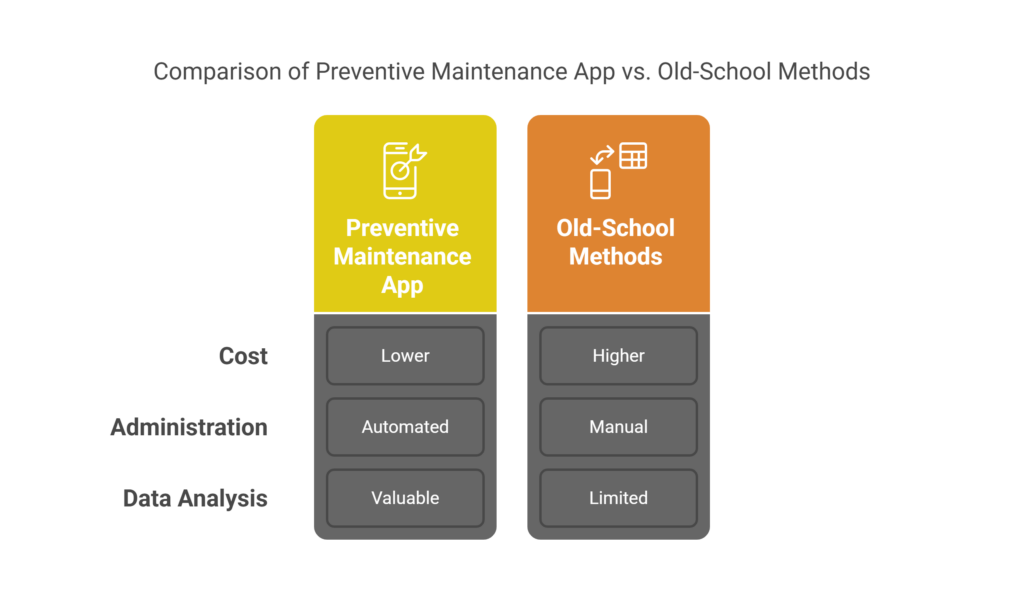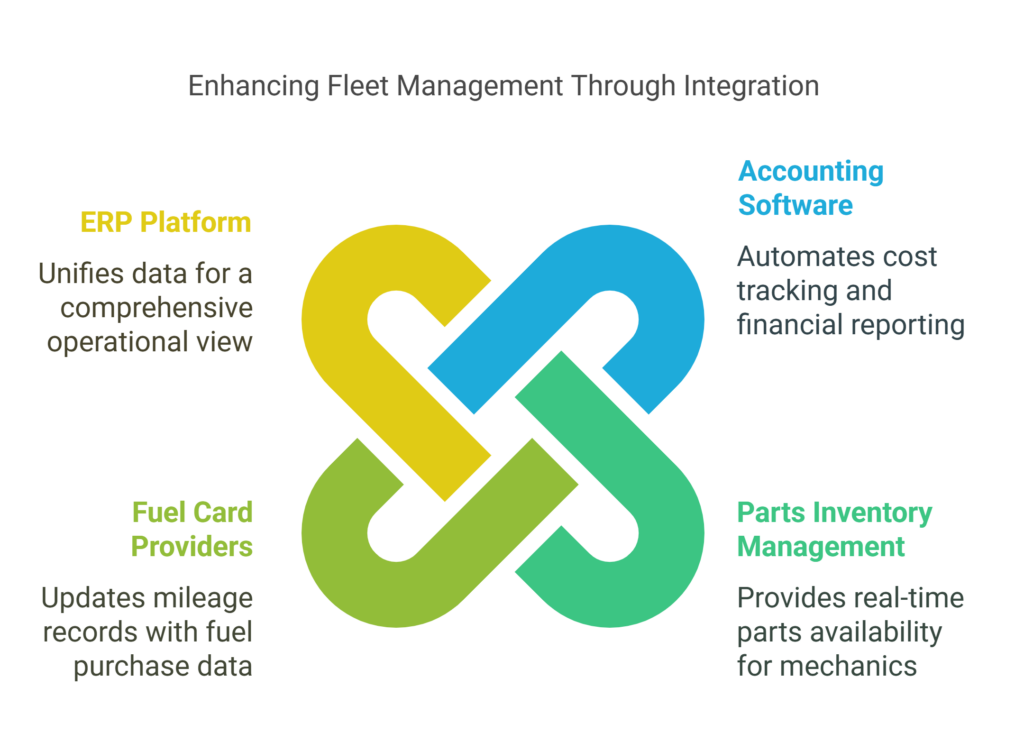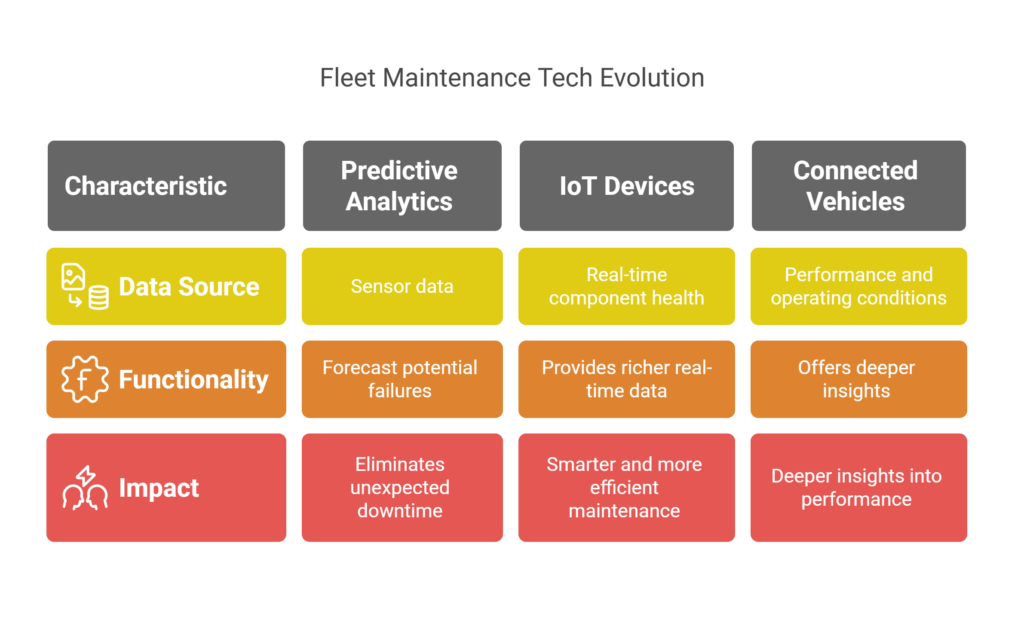Fleet management operations constantly juggle vehicle downtime, climbing maintenance costs, and the need for peak operational efficiency. A fleet maintenance app completely changes how businesses keep tabs on, care for, and get the most out of their vehicle fleets. From slashing expenses 💸 to making vehicles last longer, these digital tools offer real-time information that helps drive smarter decisions and top-tier operations. Let’s look at how fleet maintenance applications can shake up your fleet operations and why businesses are increasingly turning to these smart tools to stay ahead in a tough market.
Understanding Fleet Maintenance Apps
So, what exactly is a fleet maintenance app? Think of it as your digital command center for keeping vehicles in prime condition. These apps take all the messy paperwork, spreadsheets, and manual tracking involved in maintenance and move it onto a clean, accessible digital platform. Instead of chasing paper trails, managers get instant access to maintenance schedules, repair histories, and vehicle statuses right from their computer or mobile device. It’s about bringing fleet care into the modern age.
These handy applications usually slot into larger broader fleet management systems, but their main job is super focused: stopping vehicle troubles before they turn into expensive headaches. By tracking everything from mileage to engine performance, they help pinpoint potential issues early. The goal isn’t just fixing things when they break, but actively preventing breakdowns through smart scheduling and timely interventions. It’s proactive care, not just reactive repair.
Fleet maintenance tech has come a long way! Gone are the days of clunky software tied to a single desktop. Today’s apps harness the power of real-time data streaming directly from vehicles, cloud computing for anywhere access, and mobile apps that put control right in your pocket 📱. This means managers, technicians, and even drivers can interact with the system, update information on the go, and get alerts instantly, offering an amazing level of control over fleet assets.
“Implementing a fleet maintenance app can enable you to have vehicle data such as mileage and engine hours be fed to you. This allows you to easily identify which vehicles are in urgent need of service and which ones still have a bit more use to go.” -Whip Around
Key Features of Effective Fleet Maintenance Apps
What makes a fleet maintenance app truly effective? It boils down to a set of core features working together seamlessly. Good apps offer a complete toolkit for managing maintenance from start to finish. This includes planning preventive work, tracking repairs, managing parts inventory, documenting inspections, and analyzing costs—all within one integrated system.
Preventive maintenance scheduling is the heart ❤️ of these apps. They allow you to set up maintenance tasks based on time intervals (like every six months) or usage metrics (like every 5,000 miles or 200 engine hours). The app automatically tracks these triggers and reminds you when service is due. This systematic approach drastically cuts down on unexpected breakdowns and keeps vehicles running smoothly.
Inspection and reporting tools are also crucial. Many apps offer mobile inspection features, allowing drivers or technicians to perform vehicle checks using digital checklists on their phones or tablets 📝. They can note defects, attach photos, and submit reports instantly. This digital trail ensures accountability and makes it easy to document compliance and track repair needs accurately.
Don’t forget alert systems and real-time notifications! 🔔 Effective apps keep managers in the loop automatically. You can receive alerts for upcoming service deadlines, newly reported defects, low inventory levels for parts, or confirmation when a repair job is finished. This instant communication helps ensure nothing falls through the cracks and maintenance runs like clockwork.
“One of the core features of any fleet maintenance app is preventive maintenance scheduling. This feature reminds you of upcoming maintenance tasks based on factors like time, mileage, or usage. Regular vehicle fleet maintenance reduces the risk of breakdowns and extends the lifespan of your vehicles.” -SimplyFleet
Cost Reduction Through Maintenance Optimization
Let’s talk money! 💰 Preventive maintenance, facilitated by an app, is almost always cheaper than dealing with major breakdowns. Catching a worn brake pad early might cost a few hundred dollars, but letting it fail could lead to rotor damage, potential accidents, and much higher repair bills, not to mention costly downtime. These apps help you stay ahead of the curve, fixing small issues before they become big, expensive problems.
Think about the hidden costs of old-school methods, too. Hours spent manually scheduling, filing paperwork, digging through records – it all adds up. Fleet maintenance apps automate many administrative tasks, freeing up staff time and reduced administrative work. Going paperless streamlines workflows, cuts down on errors, and saves significantly on labor and supply costs. It’s efficiency you can bank on.
Beyond direct savings, maintenance apps generate valuable data. Analyzing this information helps spot trends and find new ways to save. Maybe one type of truck constantly needs a certain repair? That insight could influence future purchasing decisions. Or perhaps maintenance costs spike at specific mileage points? That data can refine your preventive schedules for better resource allocation. Knowledge is power, especially when it reduces overall fleet costs.

“In addition to the reduced expenses through preventive maintenance, there are additional ways implementing a fleet maintenance app can help minimize costs even further. The application can maximize efficiency, helping you identify the cost-saving areas often difficult to discover through paper-based practices.” -Whip Around
Minimizing Vehicle Downtime
When a vehicle is off the road, it’s not making money – it’s costing money. Vehicle downtime messes up schedules, delays deliveries or service calls, and can seriously frustrate customers. Keeping vehicles operational is absolutely vital for business continuity and maintaining a good reputation. Minimizing downtime isn’t just nice; it’s essential.
This is where fleet maintenance apps shine ✨. By automating preventive maintenance schedules, they ensure vehicles get serviced *before* they break down unexpectedly. When issues do arise (often flagged during digital inspections), the app streamlines the repair process. Work orders can be generated quickly, assigned to technicians, and tracked through completion, getting vehicles back on the road faster.
Smart planning also plays a big role. Because the app gives you a clear view of upcoming maintenance needs across the fleet, you can schedule service strategically. Need to service Truck A next week? Check its schedule and plan the work during its expected off-peak hours or days. This proactive approach avoids pulling vehicles from active duty during critical operational periods, keeping disruptions to a minimum.
“The downtime of equipment is a scourge for any maintenance or fleet manager. Everybody is affected by equipment that goes down, and this is especially true when you don’t have a plan to deal with it. Projects are delayed. Employees can be annoyed. The relationships with clients can be damaged.” -A3Logics
Enhancing Vehicle Lifespan and Performance
Your vehicles are major investments. Naturally, you want them to last as long as possible and give you the best return. Consistent, timely maintenance guided by an app is key to extending vehicle lifespans. Regular oil changes, fluid checks, tire rotations, and addressing minor issues promptly prevent excessive wear and tear, keeping assets running reliably for years longer.
It’s not just about longevity; it’s about performance too. Well-maintained vehicles simply run better. They tend to have better fuel efficiency (saving money at the pump!), produce fewer harmful emissions (good for the environment and compliance ✅), and operate more reliably day-to-day. An app helps ensure all the little things that contribute to peak performance are consistently taken care of.
Over time, the historical maintenance data collected by the app becomes a goldmine. You can see exactly what work has been done on each vehicle, when, and at what cost. This history helps identify recurring problems with certain makes or models, informs decisions about when to retire older vehicles, and guides better purchasing choices for future fleet additions. It’s data working for your bottom line.
“Having instant and easy access to all this information can help simplify and streamline your preventive maintenance process. The software can also alert you of vehicle fault codes the instant they occur so you can address them immediately. This keeps your fleet vehicles in optimum condition, which then extends their lifespan and saves you money.” -GoMotive
Real-time Fleet Monitoring and Insights
Imagine knowing exactly where your vehicles are, what they’re doing, and how they’re performing, right now. Many fleet maintenance apps integrate with telematics or GPS systems to provide exactly that. This real-time tracking offers immediate visibility into your fleet’s pulse, showing vehicle location, speed, status (idle, moving, parked), and even diagnostic trouble codes (DTCs) or alerts.
This stream of live information allows managers to be incredibly proactive. See a check engine light pop up remotely? You can schedule service immediately. Notice a vehicle idling excessively? You can address fuel waste. Is a driver heading off-route? You can check in. Having this immediate awareness means you can tackle small issues before they snowball into bigger operational disruptions.
Beyond the immediate responses, all this real-time data builds a rich historical record. Analyzing these datasets over weeks, months, or years reveals deeper operational patterns, performance benchmarks, and areas for strategic improvement. It transforms fleet management from guesswork into a data-backed discipline, paving the way for smarter long-term planning.
“The real-time information the maintenance app relays to you allows you to be as informed as you possibly can; being able to identify trends and patterns that could impact your business negatively. You can get reports on equipment utilization, labor, service history, and so much more.” -Whip Around
Improving Driver Experience and Safety
Happy drivers are often safer, more productive drivers 😊. Providing them with well-maintained, reliable vehicles shows you care about their comfort and safety. A fleet maintenance app ensures vehicles are consistently checked and serviced, reducing the likelihood of breakdowns or uncomfortable operating conditions. This contributes positively to driver morale and job satisfaction.
Safety is paramount in fleet operations. Regular maintenance is fundamental to vehicle safety. Properly inflated tires, working brakes, clear visibility – these are non-negotiable. A maintenance app helps ensure these critical checks happen routinely. Fewer breakdowns also mean fewer instances of drivers being stranded in potentially unsafe locations or situations. It’s a direct investment in your team’s well-being.
Some advanced systems, like those integrated with telematics, can combine maintenance data with driver behavior monitoring (speeding, harsh braking). This holistic view allows managers to connect driving habits with vehicle wear and tear, creating targeted training opportunities and fostering a stronger safety culture across the entire operation.
“The often lengthy back-and-forth communication between commercial drivers, field staff, managers, and even customers isn’t just distracting (and extremely dangerous) for commercial drivers; it may also negatively affect an operator’s work experience.” -GoMotive
Integration with Business Systems
A fleet maintenance app shouldn’t live in a silo. The best ones are designed to connect and share data with other essential business systems. Think about linking it to your accounting software, parts inventory management systems, fuel card providers, or even your main Enterprise Resource Planning (ERP) platform. This connectivity creates a truly unified operational view.
What are the perks of integration? Imagine maintenance costs automatically flowing into your accounting system. Or mechanics being able to check real-time parts availability directly from a work order. Maybe fuel purchase data automatically updates mileage records. This seamless data flow eliminates duplicate data entry, reduces errors, speeds up processes like billing and reporting, and gives you powerful business analytics.
This is an area where a platform like Nektar.io truly excels. Nektar.io is built with integration in mind, offering robust capabilities to connect your fleet maintenance data with the rest of your business operations. By linking maintenance activities, costs, and insights with other departments, Nektar.io helps you achieve maximum efficiency and gain a comprehensive understanding of your operational health.

“The application is capable of easily integrating with other software applications such as account management and parts suppliers. The capability of updating and collating information in real-time reduces the paper-based administrative duties and increases productivity, which ultimately reduces the costs incurred even further.” -Whip Around
Compliance Management and Documentation
Staying compliant with industry regulations (like DOT rules, emissions standards, or safety certifications) is a major responsibility for fleet operators. Fleet maintenance apps are fantastic tools for this. They provide a structured way to schedule required inspections, track compliance tasks, and maintain detailed, easily accessible digital records of all maintenance and inspection activities.
These apps help manage various compliance requirements. Need to prove regular safety checks? The digital inspection reports are your evidence. Tracking emissions test dates? Set automated reminders in the app. Need maintenance records for a DOT audit? Generate a comprehensive report with a few clicks. The app centralizes everything needed to demonstrate adherence to regulations.
Automating record-keeping significantly reduces the risk of non-compliance due to lost paperwork or missed deadlines. Digital records are secure, organized, and readily available. This simplifies audit preparations immensely and helps protect the business from potential fines, penalties, or even legal trouble associated with compliance failures. Peace of mind is a valuable benefit! 👍
Data-Driven Decision Making
Beyond the day-to-day grind of scheduling oil changes, fleet maintenance apps unlock a wealth of data that can fuel smarter strategic decisions. The analytics and reporting features turn raw maintenance data into actionable insights about your fleet’s overall health, costs, and performance trends. This moves fleet management from reactive problem-solving to proactive optimization.
What kinds of insights can you gain? You can compare the total cost of ownership across different vehicle makes and models. Analyze which parts fail most often. Identify trends in fuel consumption related to maintenance cycles. Optimize vehicle replacement strategies based on lifecycle cost data. These insights help fine-tune operations for maximum efficiency and profitability.
Leveraging this data creates a serious competitive edge. Businesses that understand their fleet metrics deeply can make better investments, control costs more effectively, and improve service reliability. It fosters a culture of continuous improvement, where decisions are backed by hard evidence rather than just gut feelings. That’s how leading fleets stay ahead.
“An efficient fleet management app should be able to track time-based and usage-based maintenance right from the platform. You should be able to customize alerts for maintenance triggers and also integrate with maintenance software. A maintenance scheduler will give you maintenance alerts for vehicles due for repairs, thus reducing unplanned downtime.” -CalAmp
Choosing the Right Fleet Maintenance App
Okay, you’re convinced an app is the way to go. But how do you pick the right one? First, take stock of your own needs. How many vehicles do you have? What types are they (trucks, vans, cars, heavy equipment)? What are your biggest maintenance pain points right now? Understanding your specific situation helps narrow down the options.
Next, evaluate potential apps based on key criteria. Is the interface intuitive and easy for your team to learn? Does it have a solid mobile app for drivers and techs in the field? What kind of customer support is offered? Can the system scale up if your fleet grows? Look for a balance of powerful features and genuine usability.
Think about the rollout process too. How will you get your existing data into the new system? What training resources are available for your staff? Does the provider offer help with integrating the app with your other software? A smooth transition is important, so ask potential vendors about their implementation support.
For a solution that ticks all these boxes, consider Nektar.io. It offers a comprehensive suite of maintenance management features, a user-friendly design praised by fleet managers, excellent integration options, and dedicated support. Nektar.io is specifically built to handle the complexities of modern fleet maintenance, making it an ideal choice for businesses seeking efficiency and control.
Case Studies: Successful Implementation
Seeing is believing! Many businesses across different industries have already reaped the rewards of switching to a fleet maintenance app. From small local service companies to large logistics operations, the impact on efficiency, cost savings, and vehicle uptime is consistently positive. These real-world examples showcase the practical benefits.
Take, for instance, a regional trucking company that was struggling with frequent breakdowns and soaring repair costs. After implementing a comprehensive fleet maintenance solution like Nektar.io, they shifted to a preventive maintenance model. Within a year, they reported a 30% reduction in emergency repairs and a 15% decrease in overall maintenance spending. Vehicle uptime improved significantly, leading to more reliable delivery schedules and happier customers.
It’s not just for transportation giants, either. A construction company with a mixed fleet of trucks, excavators, and smaller equipment used a maintenance app to gain control over their assets. Digital inspections helped catch issues early, while automated scheduling ensured vital equipment was always ready for jobs. They reduced costly project delays caused by equipment failure and gained better insights into the lifecycle costs of their machinery, improving future purchasing decisions.
Future Trends in Fleet Maintenance Technology
The evolution of fleet maintenance tech isn’t slowing down! Exciting developments are on the horizon. Think predictive analytics, where AI algorithms analyze sensor data to forecast potential failures *before* they happen 🤖. Imagine IoT (Internet of Things) devices providing even richer real-time data on component health. The future is about being even more proactive and data-informed.
These advancements promise to make fleet maintenance smarter and more efficient than ever. Predictive maintenance could virtually eliminate unexpected downtime. AI might optimize maintenance schedules based on complex variables impossible for humans to track manually. Connected vehicles and infrastructure will offer deeper insights into performance and operating conditions.

Staying ahead means choosing partners who embrace innovation. Nektar.io is committed to being a forward-thinking platform, continuously exploring and integrating valuable new technologies. By choosing Nektar.io, you’re not just getting a great solution for today; you’re investing in a platform designed to adapt and grow, keeping your fleet operations competitive in the future.
“Beyond preventative maintenance tracking, some of the more advanced fleet management solutions are even starting to integrate predictive maintenance functionality into their platform. If you want to get ahead of the maintenance technology curve, consider a provider that offers predictive capabilities.” -CalAmp
Frequently Asked Questions
What is a fleet maintenance app and how does it work?
A fleet maintenance app is basically digital software designed to help businesses manage the upkeep of their vehicles. It replaces paper logs and spreadsheets with features for scheduling maintenance, tracking repairs, managing parts, and documenting inspections. These apps often collect data directly from vehicles (like mileage or fault codes) or through user input (like inspection results) to trigger maintenance alerts and generate reports for better fleet management.
How can a fleet maintenance app reduce business costs?
There are several ways these apps save money! Primarily, they enable preventive maintenance, catching small issues before they become costly major repairs. They also optimize scheduling and resource allocation, reducing wasted time and labor. By streamlining administrative tasks and going paperless, they cut overheads. Plus, well-maintained vehicles last longer and often use fuel more efficiently, adding to the savings.
What features should I look for in a fleet maintenance app?
Key things to look for include robust preventive maintenance scheduling (based on time, mileage, hours, etc.), mobile inspection capabilities with digital checklists, real-time alerts and notifications, work order management, parts inventory tracking, strong integration options with other business systems, comprehensive reporting and analytics, and importantly, an interface that’s easy for your team to use.
How difficult is it to implement a fleet maintenance app across an organization?
It varies, but modern solutions like Nektar.io are designed to make implementation as smooth as possible. They typically offer intuitive interfaces that reduce the learning curve, provide training materials and support, assist with migrating your existing data, and may allow for phased rollouts. While any change requires some adjustment, good providers work hard to minimize disruption and get you up and running efficiently.
Can fleet maintenance apps integrate with existing business systems?
Absolutely! Good fleet maintenance apps are built to play nicely with others. They often offer integrations with accounting software (like QuickBooks or Xero), parts inventory systems, fuel card programs, telematics/GPS providers, and even larger ERP systems. This connectivity creates a seamless flow of information across your business, boosting efficiency and providing a more complete operational picture.
Conclusion
Fleet maintenance apps are truly game-changing tools for any business running a vehicle fleet, big or small. By moving maintenance processes into the digital age, these applications wipe out old inefficiencies, cut costs significantly, and give you amazing visibility into how your fleet is doing. The advantages go way beyond just tracking oil changes – we’re talking longer vehicle life, happier drivers, better safety records ✅, and smart, data-driven decisions that set your business up for long-term success.
Nektar.io is leading the charge in this tech shift, offering a complete fleet maintenance platform tailored for today’s business challenges. With easy-to-use interfaces, powerful analytic tools, smooth integrations, and helpful support, Nektar.io helps businesses squeeze every bit of value from their fleet investments while cutting down operational headaches. Whether you manage a handful of local vans or a massive national fleet, adopting Nektar.io’s fleet maintenance solution can lead to major gains in efficiency, compliance, and your bottom line. Reach out to Nektar.io today to see how their specialized fleet maintenance app can upgrade your operations and give you a lasting edge in your industry. ✨
Key Takeaways:
- Fleet maintenance apps significantly reduce operational costs through preventive maintenance and efficient resource allocation
- Vehicle downtime decreases dramatically with scheduled maintenance and early problem detection
- Real-time insights enable proactive management decisions and strategic planning
- Vehicle lifespans extend considerably with consistent, app-guided maintenance
- Compliance management becomes streamlined with automated documentation and record-keeping
- Driver satisfaction and safety improve with reliable, well-maintained vehicles
- Integration capabilities connect maintenance operations with broader business systems
- Nektar.io offers comprehensive features specifically designed for modern fleet maintenance challenges



